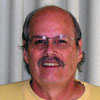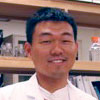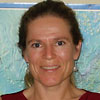 |
Zbigniew Kolber
- Chief Scientist, CMORE faculty • Monterey Bay Aquarium Research Institute (MBARI)
- I am interested in mechanisms of photosynthesis in marine phytoplankton and aerobic anoxygenic photosynthetic bacteria. I am developing
instrumentation for assessing photosynthetic performance of these organisms using fluorescence-based technique. Our approach allows assessing the
efficiency of light utilization, the yield of photochemistry, and the rates of photosynthetic electron transport in photosystem II and photosystem I.
We will use this approach on the OPEREX cruise to monitor photosynthetic properties of phytoplankton and photosynthetic bacteria along the cruise
track, and within the water column. We will also monitor the progress of the incubation experiments.
|
 |
Miriam Sutton
- Teacher • Newport Middle School, NC
- I have been assigned to the C-MORE/OPEREX research cruise as a Teacher-at-Sea. During the cruise, I will provide communication and develop
educational activities that will assist teachers and scientists to bring the research project into the classroom. My main objectives are to
establish an online blog to communicate with teachers and students while at sea; to develop simplified experiments that link the cruise activities
to the classroom; interact and assist scientists with their research projects; and generate photo/video documentation of the research cruise.
|
 |
Allison Fong
|
 |
Lionel Guidi
- Postdoctoral Scholar • University of Hawai‘i at Manoa (UHM)
- (with Lars Stemmann) Our common interest is to study the element cycle in the first 1000 m of the oceans with a technological, biogeochemical physical and mathematical point of view. We are specially interested in the fate of the phytoplankton bloom. How efficient is the biological or physical aggregation of phytoplankton production into larger fast settling particle is the central question.
|
 |
Lars Stemmann
- Assistant professor • Universite Pierre et Marie Curie
- (with Lionel Guidi) Our common interest is to study the element cycle in the first 1000 m of the oceans with a technological, biogeochemical physical and mathematical point of view. We are specially interested in the fate of the phytoplankton bloom. How efficient is the biological or physical aggregation of phytoplankton production into larger fast settling particle is the central question.
|
 |
Whitney Krey
- Graduate Student • MIT-WHOI Joint Program (Massachusetts Institute of Technology and Woods Hole Oceanographic Institution)
- General research interests: Heterotrophic bacteria diversity and physiology, with emphasis on trace metal metabolism and uptake strategy.
- Cruise objectives: High-volume filtration for a comparative transcriptomic and proteomic study of heterotrophic bacteria in the field. DNA/RNA filtration for general lab genomics work.
|
 |
Craig Taylor
- C-MORE faculty • Woods Hole Oceanographic Institution (WHOI)
- We are interested in applying autonomous instrumentation for the time series measurement of microbial rate processes. To effect these measurements we
have developed the Time Series-Submersible Incubation Device (TS-SID) that can conduct multiple in situ incubation studies for up to a year for quantifying
the rates of transformation of select tracers. We are initially focusing on high temporal resolution measurements of primary production during bloom
events. During the OPEREX cruise we will deploy the TS-SID on a free drifting spar buoy system to follow the changing dynamics of primary production
during bloom development. The spar buoy possesses an Iridium satellite GPS transceiver for measuring the position of the TS-SID within the bloom during
the deployment.
|
 |
Jamie Becker
- Graduate Student • Woods Hole Oceanographic Institution (WHOI)
- We are interested in the characterization and cycling of dissolved organic matter (DOM). Our main objective for this cruise is to examine the effect of DOM size fractionation on microbial activity. Size fractionation of organic matter will be done using an ultrafiltration system on board the ship and microbial activity will be monitored via measurements of dissolved organic carbon, dissolved oxygen, and bacterial production through collaborations with Donn Viviani and Matt Church at the University of Hawaii. We will also try to estimate the age of degraded organic matter using natural carbon-14 abundance and examine microbial community structure changes through genomic analysis of both DNA and RNA.
In addition, we will be taking depth profile samples to characterize colored dissolved organic matter and dissolved organic phosphorous in bloom-induced waters.
|
 |
Mar Nieto Cid
- C-MORE Postdoctoral Scholar • Woods Hole Oceanographic Institution (WHOI)
- We are interested in the characterization and cycling of dissolved organic matter (DOM). Our main objective for this cruise is to examine the effect of DOM size fractionation on microbial activity. Size fractionation of organic matter will be done using an ultrafiltration system on board the ship and microbial activity will be monitored via measurements of dissolved organic carbon, dissolved oxygen, and bacterial production through collaborations with Donn Viviani and Matt Church at the University of Hawaii. We will also try to estimate the age of degraded organic matter using natural carbon-14 abundance and examine microbial community structure changes through genomic analysis of both DNA and RNA.
In addition, we will be taking depth profile samples to characterize colored dissolved organic matter and dissolved organic phosphorous in bloom-induced waters.
|
 |
Laure Anne Ventouras
|
 |
Ryan Paerl
- Graduate Student • University of California Santa Cruz (UCSC)
- Activities planned on the OPERX cruise: 15N2 incubations with collected SW; DNA/RNA filtrations from select stations largely to examine possible; nitrate
assimilating communities and/or activity; 15NO3- incubations of upper euphotic and near DCM SW from in and out eddy stations; SN, NH4+ media enrichments.
(And I plan to log a few more captain hours, as in the case of my photo.)
|
 |
Sasha Tozzi
- C-MORE Postdoctoral Scholar • Monterey Bay Aquarium Research Institute (MBARI)
- My science interests include phytoplankton ecology and photophysiology, marine primary production; environmental forcing and regulation of phytoplankton biomass and production; photosynthesis biophysics with a main interest in studies based on fluorescence bioassays. On this cruise I plan to explore the effects of temperature, nutrients and pCO2 on central North Pacific phytoplankton assemblages' photosynthesis by using MBARI custom designed and built chemostats and Fast Repetition Fluorometers (FRRF). I will help the MBARI group to survey photosynthetic quantum yield of a bloom associated to a mesoscale eddy and with experiment designed to simulate and compare present ocean condition to conditions forecasted for one hundred years from now.
|
 |
Alan Foreman
- C-MORE Intern • Monterey Bay Aquarium Research Institute (MBARI)
- I have a very strong interest in marine ecology and chemistry, and I think that the interconnectivity of the ocean\92s organisms and the study of the relationships between these populations and environmental conditions are both fascinating and have important implications for the future.
- On this cruise I will be attempting to determine how changes in ocean pH will affect a range of biophysical processes involved in photosynthesis and respiration. To do so, I will be using FRR fluorometry to monitor the effects of pH changes on phytoplankton in situ.
|
 |
Jennifer Brum
- Graduate Student • University of Hawai‘i at Manoa (UHM)
- Research Interests: I am interested in the diversity and ecology of aquatic viruses.
- Work Planned for the OPEREX Cruise: My major research goal of this cruise is to work with Donn Viviani to measure the amount of production that
is lysed by viruses vs the amount of production that is grazed, in and out of a bloom. To do this, we will be measuring grazing, viral lysis,
virus production, primary production, and heterotrophic production at two time points in the bloom and one time point out of the bloom. I will
also be opportunistically collecting samples for viral abundance and percent of bacteria infected with viruses in the large incubations and possibly
in sediment traps.
|
 |
Sam Wilson
|
 |
Katie Watkins
|
 |
Karen Breitlow
|
 |
Solange Duhamel
- C-MORE Postdoctoral Scholar • University of Hawai‘i at Manoa (UHM)
- Science interests: I am interested in the dynamics of phosphorus (P) biogeochemistry and bioavailability and its link with C and N cycling. I am particularly interested in heterotrophic prokaryotes and phytoplankton P incorporation pathways (direct incorporation from DIP or indirect incorporation from DOP) and in the algal-bacterial competition for P. I develop cell-specific indicators of nutritional status such as ELF-P-labeling (Enzyme-Labeled Fluorescence).
- Cruise objectives: My objectives are to better understand the P incorporation pathways (direct and indirect) of both heterotrophic prokaryotes and phytoplankton cells in the different conditions that will be studied during the cruise (eddies, bloom, perturbation experiments). I would like to learn which compounds are used and at which rates but also to be able to tell which organisms are responsible for these activities. I plan to meet these objectives by measuring APA at bulk and single cell levels using DiFMU-P and ELF-P substrates respectively, all over the transect. I also plan to collaborate with other participants in mixing experiments studies and in measuring specific labeling of cell groups using 32P and selected DOP compounds for isotope dilution effects combined with flow cytometry cell sorting.
|
 |
Jason Hilton
- Graduate Student • University of California Santa Cruz (UCSC)
- I will be focusing on assessing the diatom-cyanobacteria symbioses present in the water column. I will be studying the diversity and distribution of these associations by collecting DNA samples and running quantitative-PCR using primers and probes targeting the /nifH/ gene of the symbiont. I will also be investigating the gluatmine-glutamate pathways of each organism in the symbiosis and the expression of the genes involved in these pathways over a diel cycle using 24-hour on-deck incubations and sampling for RNA.
|
 |
Paulo Cali
- Graduate Student • University of Hawai‘i at Manoa (UHM)
- Research Interests: Meso- and Submesoscale dynamics and Biophysical Interactions
- Cruise assignments: HPLC measurements, interest in submesoscale nutrient injections
|
 |
Binglin (Ben) Li
|
 |
Donn Viviani
|
 |
Brett Updyke
|
 |
Ken Doggett
|
 |
Steve Poulos
|
 |
Karin Björkman
|
 |
Tim McGovern
|
 |
Tobin Chen
|































